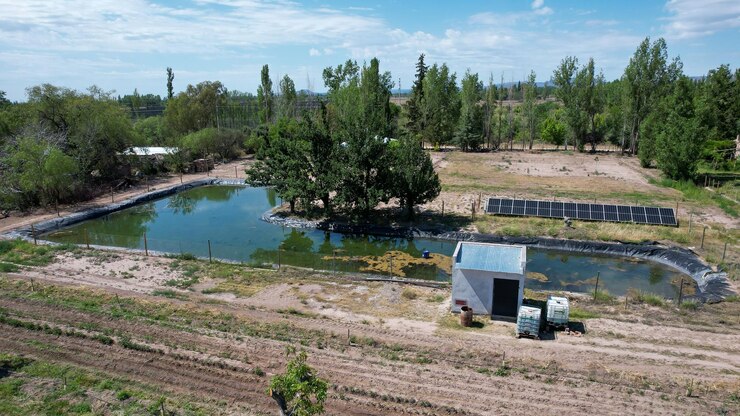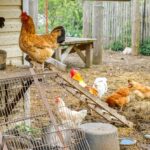Access to reliable and affordable irrigation is a major challenge for off-grid farms, especially in remote or rural areas where electricity and fuel supplies are limited. Solar-powered irrigation systems (SPIS) are emerging as a practical and sustainable solution, helping farmers increase productivity while reducing dependence on fossil fuels.
This article explores how solar-powered irrigation works, its benefits, and what farmers need to consider when implementing the system.
What is a Solar-Powered Irrigation System?
A solar-powered irrigation system uses solar panels to convert sunlight into electricity, which then powers a water pump. The pump lifts water from a well, river, borehole, or reservoir and delivers it to crops through surface or drip irrigation systems.
Key components include:
- Solar panels – generate electricity from sunlight
- Controller/inverter – regulates the power and may convert it from DC to AC if needed
- Water pump – can be submersible or surface-based depending on the water source
- Water storage tank – stores water for use during cloudy days or at night
- Irrigation network – distributes water to crops
Why Solar-Powered Irrigation Makes Sense for Off-Grid Farms
- Energy Independence
Off-grid farms are often located far from electricity grids, making diesel or petrol pumps the default choice. Solar systems provide a reliable, renewable energy source without the cost and logistics of fuel transport. - Low Operating Costs
After the initial setup, operating costs are minimal. Solar panels require little maintenance and have a long lifespan, usually around 20–25 years. - Increased Agricultural Productivity
With consistent irrigation, farmers can extend growing seasons, plant higher-value crops, and reduce losses due to drought or water shortages. - Environmental Sustainability
Solar irrigation reduces greenhouse gas emissions and environmental pollution compared to diesel engines. It also supports water-efficient technologies like drip irrigation, promoting sustainable farming. - Scalability and Flexibility
Systems can be tailored to suit small plots or large fields. Farmers can expand the system over time by adding more panels or upgrading the pump.
Factors to Consider Before Installation
While solar irrigation has clear benefits, careful planning is essential for success.
1. Water Availability
Ensure a reliable water source that meets the volume needed for crop irrigation. Seasonal variations and long-term sustainability should also be evaluated.
2. Solar Resource
Adequate sunlight is critical. Most regions near the equator receive sufficient solar radiation, but localized shading or cloud cover can affect performance.
3. Pump and Panel Sizing
Proper sizing ensures the system meets water demand. Key factors include:
- Depth and distance of the water source
- Daily irrigation requirements
- Crop type and area under cultivation
Consulting an expert or using a solar pump sizing calculator is recommended.
4. Initial Investment
While long-term savings are significant, upfront costs for panels, pumps, and installation can be high. Financial support, government subsidies, or group ownership models can help offset these costs.
5. Maintenance and Training
Regular cleaning of panels and routine checks on pumps and wiring keep the system efficient. Training farmers or technicians in basic maintenance ensures reliability.
Types of Solar Pumps for Irrigation
- Surface Pumps: Ideal for lifting water from shallow sources like ponds or rivers.
- Submersible Pumps: Used for deeper water sources such as boreholes and wells.
- Centrifugal and Positive Displacement Pumps: Chosen based on the water volume and pressure requirements.
Best Practices for Solar Irrigation
- Use water-efficient methods like drip or sprinkler irrigation to maximize solar pump performance.
- Irrigate during daylight hours to reduce battery dependence and maximize solar output.
- Combine with water storage tanks to build a buffer for cloudy days or nighttime use.
- Monitor and record performance to identify any issues early and optimize system use.
Real-World Impact
In regions such as sub-Saharan Africa, South Asia, and parts of Latin America, solar irrigation is transforming small-scale agriculture. Farmers report higher yields, lower costs, and greater resilience to climate variability. Community systems, supported by cooperatives or local governments, are also gaining traction.
Solar-powered irrigation systems offer a clean, cost-effective, and reliable solution for off-grid farms. By tapping into renewable energy, farmers can improve food security, reduce input costs, and build resilience in the face of climate change. As solar technology becomes more accessible and affordable, it has the potential to revolutionize irrigation for millions of off-grid farmers around the world.
Join 'Farmers Mag' WhatsApp Channel
Get the latest Farming news and tips delivered straight to your WhatsApp
CLICK HERE TO JOIN






